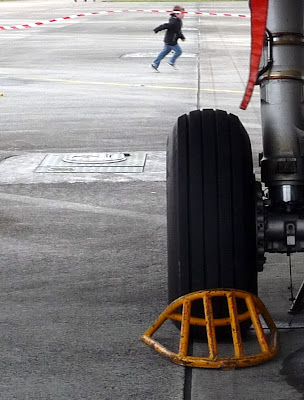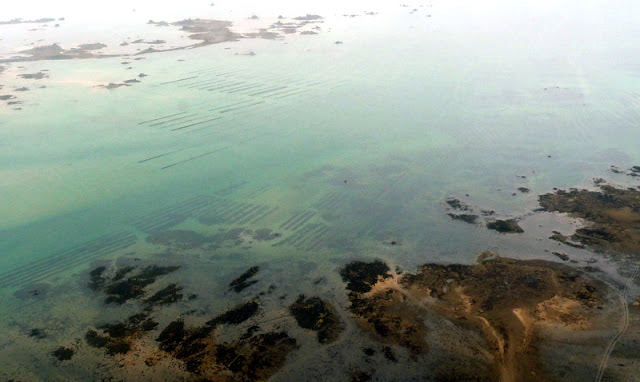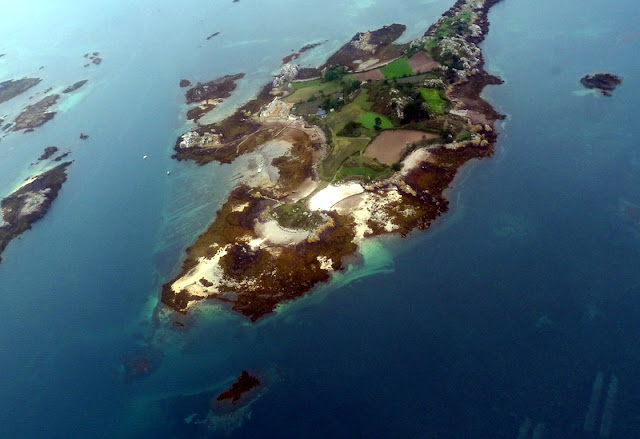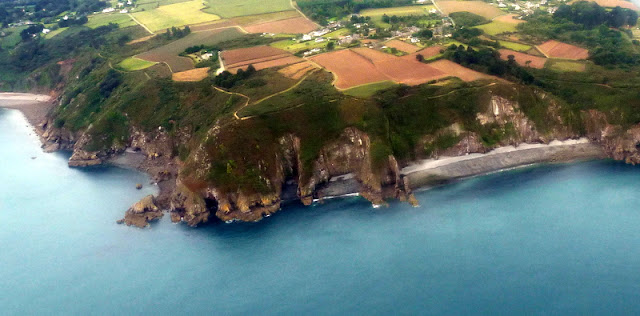But we've had some good days out gratis in September, and if we are at Kerbiriou, as we have been for the last couple of years, Yvette and Paul always have a local paper with a list and articles about what's available on the days to look at over breakfast. Last year we sampled Morlaix museum and gallery which had a contemporary art expo on at the time, but I'm afraid the most memorable thing about the occasion was that I became rather impatient to leave and tried to do so by an emergency exit which set all the alarms ringing and a man had to come running to stop them and tell me off. We also went to a mediaeval festival at a château nearby, which was quite good.
This year though, the day dawned chilly and grey, and we didn't really fancy gardens or a reprise of the museum, but looking through the options in Ouest France for the area, I saw the naval air base at Landivisiau was open, with a selection of aircraft from the vintage to the latest jet fighters.
Now despite the fact that if Tom is asked, as he was by Barrett Bonden not long ago, about his time in the Air Force, he is likely to give a terse and unenthusiastic reply to the effect that it was mostly a story of years of frustration and boredom, it doesn't take much for his eyes and enthusiasm to kindle at the very thought of military aircraft, and for myself, since my adolescent dalliance with Biggles, I have always had a penchant for any kind of flying machine.
So the birthday outing was decided.
There were plenty of different flying things to look at,
of all shapes and sizes.
There were glossy smooth surfaces,
and rougher, more weather-beaten ones.
And there was a real live Rafale, the French answer to the Eurofighter, which really floated Tom's boat (or lifted his ailerons, or whatever), with a real live Rafale pilot, who looked like he might have just completed his final adolescent growth spurt, and who was very happy to enumerate, in delightfully careful English ('I have trained in the USA') the reasons his aeroplane whupped the ass of the Eurofighter in every possible way.
Tom was certainly fairly well sold. The other day I heard strange heavy metal sounds coming from the computer accompanied by gasps and exclamations. When asked he replied 'I'm watching a video of the Rafale taking off!'
For me, though, that these spiky-looking weapons platforms all bristling with their unfathomable killer technology don't do a great deal for me aesthetically (and I'm not up for arguing any moral points about modern warfare here); the only thing that really caught my eye was this screen in the front of the cockpit, with its dragon-fly iridescence.
So which was your favourite Thunderbird? Mine was, of course, Thunderbird 2, all lumbering and gentle and capacious, motherly, you might say.
Indeed, rather like this lovely beast, a Breguet Atlantic 2, (except sadly, unlike Thunderbird 2, it wasn't green).
I liked this plane so much, and took pictures of all sorts of bits of it from all sorts of angles,
including its innards,
We happily queued for quite a long time to see inside it, it is enormous and full of screens and knobs and buttons and seats and bunks and nooks and crannies (but I couldn't photograph anything inside), it needs a crew of at least 13, and it seems to me a wondrous and complex organism.
I also liked its charming and dashing flight engineer, who showed us the outside. Looking up into its workings, I asked him if he or anyone understood all of it, or did everyone who worked on it just know a part, and he looked dreamy and approving and said he felt he was just beginning to, that he had worked with this and only this plane for twenty years and he was still learning.
In fact the whole occasion was notable as much for the conviviality and charm of the people we met, from the pilots and engineers to the rangy and very young aviatrix from the local flying club who showed us the little WW2 era wood and canvas monoplane with a dashboard like a Morris Minor, to the naval officers who were clowning for the groups of kids, wrapped up against the cold and stoically eating their picnics, whom we sat with for our lunch - buns and hot chocolate in one of the hangars.
A remarkably enjoyable day out.


































































